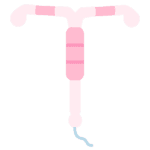DETAILS: The intrauterine contraceptive device (IUD) is a small, flexible plastic frame with copper sleeves or wire around it that is inserted into your womb by a trained healthcare professional. The copper makes it more difficult for sperm to reach an egg and survive. It can also stop a fertilised egg from implanting itself. It is more than 99% effective in preventing pregnancy, and it lasts for 5 to 10 years, depending on the type. HOW TO: An IUD needs to be fitted by a trained healthcare professional. The appointment takes about 20 to 30 minutes and fitting the IUD should take no longer than 5 minutes. Having an IUD fitted can be uncomfortable, and some people might find it painful. Some women get period-type cramps afterwards, but you can use painkillers to ease the cramps. You may also bleed for a few days after having an IUD fitted. You can have your IUD removed at any time by a healthcare professional. As you can get pregnant as soon as the IUD has been taken out, use additional contraception, such as condoms. CONS: You may experience: These changes in bleeding are normal and are not harmful. If you find them bothersome, speak to your healthcare professional. Details / How to
Pros / Cons
Frequently Asked Questions
PROS:
SIDE EFFECTS:
This website uses cookies to improve your web experience.




